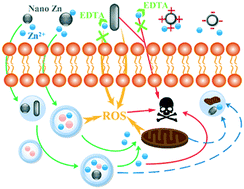Unique interplay between Zn2+ and nZnO determined the dynamic cellular stress in zebrafish cells†
Abstract
Although both dissolved Zn2+ and nano-ZnO (nZnO) contribute to ZnO toxicity, their specific roles as well as intracellular transformation and transport are inconclusive. In this study, for the first time, nZnO particles with different physicochemical properties were synthesized to provide different dissolution potentials and subcellular behaviors. We then examined the inter-relationships between extra/intracellularly dissolved Zn2+ and subcellular stress responses in zebrafish cells. A novel Zn2+-initiated aggregation-induced emission fluorogen was used to quantify the dissolution of nZnO and trace the intracellular transport of labile Zn2+. Over a 24 h exposure to nZnO, the extracellular dissolution potential determined the intracellular Zn2+ level. However, the low extracellular dissolution potential of nZnO stimulated lysosomal accumulation and reactive oxygen species (ROS) production. We showed that the lysosome was the first cellular system to process the internalized Zn, which resulted in two peaks of ROS production caused by activated lysosomes and then by mitochondrial burdens. The dissolution ability of nZnO could not perfectly explain the cellular stress, whereas both the contents and properties of nZnO determined more. Our study demonstrates a unique interplay between Zn2+ and nZnO, which subsequently determined the dynamic cellular stress caused by nZnO.



 Please wait while we load your content...
Please wait while we load your content...